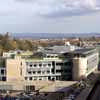PFI Architecture, PPP Scotland, Project, Debate, Controversy, Scottish School Building News
Public Finance Initiative : PFI Procurement
Procurement Policy on Architecture for Scotland – Martin Hulse article
PFI Procurement
PFI schemes in Scotland are failing to attract sufficient quality investors. The Scottish Executive held an open day in Jun 2004 to publicise new projects and attract finance into Scottish PFI schemes such as hospitals and schools.
Some organisations are wary of negative publicity surrounding PFI projects such as the East Lothian Schools debacle. However, the Scottish Executive reportedly suggested reduced numbers of bidders for projects does not reflect loss of interest in PPP but relates to the quantity of work in Scotland.
Jul 2004
Cockburn Association Comment on Scottish PFI Procurement
THE PROCUREMENT OF PUBLIC BUILDINGS IN SCOTLAND
A Policy on Architecture for Scotland is a valuable contribution to the task of raising the standard of architecture in the country. One of the key objectives contained in this document is ‘to promote a culture of quality in the procurement of publicly funded buildings that embrace good design as a means of achieving value for money and sustainable development’. It appears to me that the area where we can have the greatest impact on the quality of new build is when a public body is client.
South of the border the CABE are playing a major role to help public bodies towards improved performance as a client, so that public buildings become beacons of design quality. CABE has had extensive and constructive discussions with a range of Government departments and agencies and plays a leading role in the Prime Minister’s Better Public Buildings initiative. Such an awards scheme was also envisaged for Scotland in the Policy on Architecture and it may be that the Royal Fine Art Commission should play a major role in its formation.
In Edinburgh a great deal of discussion is being undertaken by the City Council about how they can revolutionise their procurement process. The failure of which has been most evident in their new schools initiative. A working group headed by Cllr Trevor Davies and containing individuals such as David Page and Alan Murray is currently undertaking a great deal of work. There is also a new Strategy being produced by the Culture and Leisure Department on Visual Arts and Crafts, which will hopefully give a prominent role to Architecture.

photo © Martine Hamilton Knight
However, while all this continues there a number of key developments that need to be examined. These include the new City Council Headquarter’s (photo above) by BDP on Waverley Station Car Park, the extension to the Usher Hall on Lothian Road by LDN, the design of the new office block at Haymarket by Reiach and Hall, the extension to the Conference Centre (undisclosed) and Waverley Station again by BDP. Are these meeting the aspirations being promoted by the Scottish Executive? They have certainly not met with approval from RFAC’s.
BDP are currently progressing their application for a new HQ building and have designed their building around sustainable principles, rather reducing the prominence of quality of design. (Though I must point out that they intend to demolish 19th century vaults underneath the car park, which is not an extremely sustainable solution).
LDN have not yet submitted their scheme for planning but it consists of an extension onto the side of the building. Schemes by RMJM and Richard Murphy have been discarded and it would make an interesting case study to examine the procurement method of this scheme. Reiach and Hall’s scheme is on behalf of Edi the publicly owned developer and again it would make an interesting case study. Much has been done to promote good design by this company, especially at Edinburgh Park.
Edi’s ‘other’ scheme has been the subject of an invited design competition has left us with a short list of four architects. Major questions have to be asked as to whether this scheme will ever be built. What we can take from this, however, is the recognition that we must strive to raise our aspirations as to what we can achieve for projects such as Waverley Station.
The Policy on Architecture encourages ‘the use of well managed design competitions for major proposals of national or local significance. It is my belief that that is the biggest development that this country needs to consider over the next decade. We should use it to provide a benchmark of what we can achieve in Scotland. It will be the proof of whether we can implement the desires that currently sit in the policy document on architecture.
Martin Hulse, Cockburn Association
Oct 2002
Comments / photos for the Scottish PFI Procurement Architecture page are welcome
Scottish Buildings

photo © Adrian Welch
Related news stories:
PFI Budget Cuts
The government’s mid-2004 proposal to cut up to £3 billion from its civil spending bill could reduce profit margins in Scottish PFI projects, construction firms have been warned. Larger projects including IT and construction are due to deliver the biggest savings.
Fiscal tightening of the PFI process would make bidding uneconomic for many companies and may damage the ongoing maintenance of Scottish buildings. All but the largest Scottish companies had already withdrawn from PFI and PPP in Scotland due to the cost of bidding.
PFI Schools
The Scottish Executive has advised it aims to build 300 Scottish Schools over the next six years using PFI – almost one primary or secondary school per week between now and 2010.
Scottish Architecture

render from V&A
Comments / photos for the PFI Architecture – Public Finance Initiative Developments page welcome
